
Zero Wing is a 1989 side-scrolling shooter arcade video game developed by Toaplan and originally published in Japan by Namco and in North America by Williams Electronics. Controlling the ZIG space fighter craft, players assume the role of protagonist Trent in a last-ditch effort to overthrow the alien cyborg CATS. It was the eighth shoot 'em up game from Toaplan, and their fourteenth video game overall.

Toaplan Co., Ltd. was a Japanese video game developer based in Tokyo responsible for the creation of a wide array of scrolling shooters and other arcade games. The company was founded in 1979 but its gaming division was established in 1984 by former Orca and Crux employees, who wanted to make games, after both companies declared bankruptcy. Their first shoot 'em up game, Tiger-Heli (1985) on arcades, was a success and helped establish Toaplan as a leading producer of shooting games throughout the 1980s and 1990s that would continue to characterize their output.
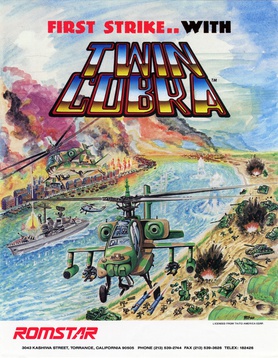
Twin Cobra, known as Kyukyoku Tiger in Japan, is a vertically scrolling shooter developed by Toaplan and released for arcades in 1987 by Taito in Japan and Europe, then in North America by Romstar. It is a sequel to the 1985 arcade game Tiger-Heli. Controlling the titular attack helicopter, the players must fight endless waves of military vehicles while avoiding collision with their projectiles and other obstacles. It was the fourth shoot 'em up game from Toaplan, and their tenth video game overall. It was ported to multiple platforms, with each done by different third-party developers that made several changes or additions.
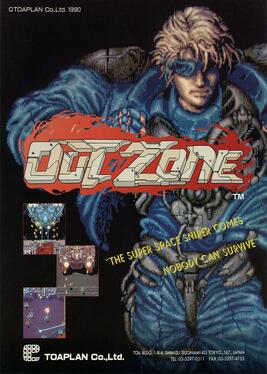
Out Zone is a run and gun arcade video game developed by Toaplan and published in Japan by Tecmo, North America by Romstar and Europe in August 1990. Set in a future where an alien race from the fictional planet Owagira are threatening to wipe out humanity after multiple failed attempts to defend Earth against their attacks, players assume the role of cyborg mercenaries recruited by the United Nations in a last-ditch effort to overthrow the invaders.
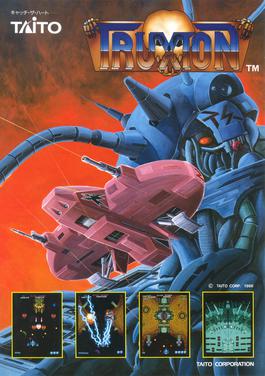
Truxton is a 1988 vertically scrolling shooter arcade video game originally developed by Toaplan and published in Japan and Europe by Taito, as well in North America by Midway. Set in a future where the Gidans alien race led by Dogurava invaded the fictional planet Borogo, players assume the role of fighter pilot Tatsuo taking control of the Super Fighter ship on a last-ditch effort to overthrow the alien invaders.

Snow Bros. is a 1990 platform arcade video game originally developed by Toaplan first published in Japan, then in North America by Romstar and later in Europe. Starring the eponymous snowmen twins Nick and Tom, players are tasked with travelling through 50 stages, throwing and building snowballs, jumping on and off platforms to navigate level obstacles while dodging and defeating monsters in order to rescue the princesses Puripuri and Puchipuchi from captivity. Although first launched in arcades, the game was later ported across multiple platforms, each one being created by different third-party developers and featuring several changes or additions compared with the original version. Conversions for various microcomputers were in development but none were officially released to the public.

Demon's World is a 1989 run and gun arcade video game originally developed by Toaplan and published in Japan by Taito and in North America by Catalina Games. In the game, players assume the role of two ghost hunters to fight against several ghosts and monsters that were unleashed upon Earth by the titular demon king. Initially launched for the arcades, the title was then ported to the PC Engine Super CD-ROM² by NEC Avenue and published exclusively in Japan on 26 February 1993, featuring various additions and changes compared with the original release.

Teki Paki is a 1991 puzzle arcade video game developed by Toaplan and published in Japan by Tecmo, Hong Kong by Honest Trading Co. and Taiwan by Spacy Co. Ltd.

Rally Bike is a racing arcade video game originally developed by Toaplan and published by Taito in May 1988. In Rally Bike, players compete against computer-controlled opponents in races across locations in the United States. Initially released in arcades, the game was ported to the Nintendo Entertainment System and X68000 by different developers.

Hellfire is a 1989 horizontally scrolling shooter arcade video game originally developed by Toaplan and published in Japan by Taito and North America by U.S.A. Games. The first horizontal shoot 'em up title to be created by Toaplan, the game takes place in the year 2998 where a space matter known as Black Nebula created by robot dictator Super Mech spreads and threatens to engulf human-controlled galaxies, as players assume the role of Space Federation member Captain Lancer taking control of the CNCS1 space fighter craft in a surprise attack to overthrow the enemies with the fighter craft's titular weapon.

Slap Fight is a 1986 vertically scrolling shooter arcade video game developed by Toaplan and published by Taito. Set on the colonized fictional planet of Theron in the future, where an alien race led by Gaudy have invaded the human-controlled location, players assume the role of an Allied League of Cosmic Nations (ALCON) fighter pilot taking control of the SW475 space fighter craft in a effort to counterattack the invaders. Initially launched for the arcades, the game was later ported to other microcomputer and console platforms by various third-party developers, with each one featuring several changes or additions compared to the original release.

Fire Shark is a 1989 vertically scrolling shooter arcade video game developed and published by Toaplan in Japan and Europe, and by Romstar in North America. It is the sequel to Flying Shark, a game released in 1987 on multiple platforms. Set in the year 1991, the game focuses on a mysterious armada launching a worldwide attack from a small island in the Mediterranean Sea. Players take control of the titular biplane to counterattack the enemy forces.
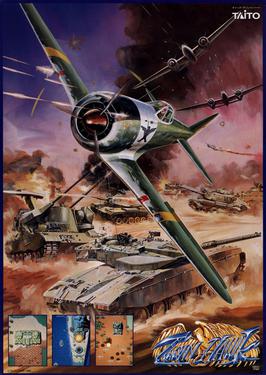
Twin Hawk is a 1989 vertically scrolling shooter arcade video game originally developed by Toaplan and published by Taito. Taking place at the end of an alternative World War II setting, where general Giovanni and his army plots to take over the fictional country Gorongo, players assume the role of a wing commander from the Daisenpū squadron taking control of a Flying Fortress fighter aircraft in an effort to overthrow the enemy.
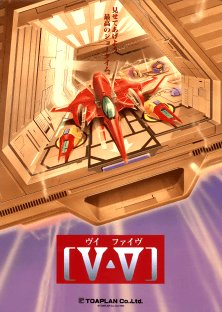
Grind Stormer is a 1993 vertically scrolling shooter arcade video game originally developed and published by Toaplan in Japan and North America. It is considered to be the spiritual successor to Slap Fight. Based around a video game within a video game concept, players assume the role of a young secret agent assigned by the government taking control of the NA-00 space fighter craft in an attempt to defeat the titular virtual reality simulator, rescue the abducted players who lost against it and unveil its true purpose.

Truxton II is a 1992 vertically scrolling shooter arcade video game originally developed and published by Toaplan in Japan and Europe. It is the sequel to Truxton, which was released earlier on arcades in 1988 and later ported to various platforms.

Knuckle Bash is a 1993 side-scrolling beat 'em up arcade video game developed and published by Toaplan in Japan, as well as North America and Europe by Atari Games. It is notable for being one of the few titles by Toaplan that has not received any official port to home consoles as of date.
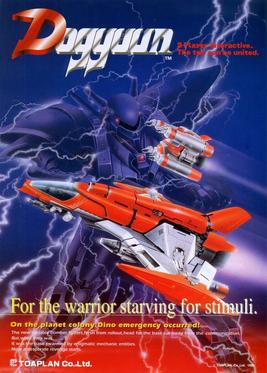
Dogyuun is a 1992 vertically scrolling shooter arcade video game developed and published by Toaplan. Set on the colonized fictional planet of Dino in the future, where an alien race of metallic robots have invaded a police communication center and held its inhabitants as hostages, players assume the role of two fighter pilots taking control of the Sylfers bomber space fighter crafts in an revenge attempt to overthrow the invaders and free the surviving colonists after one of their comrades is killed by one of them during a reconnaissance assignment.
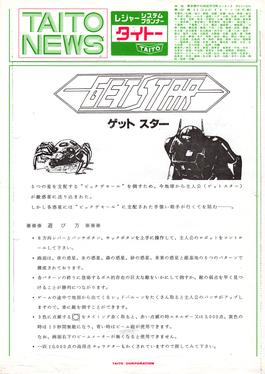
Guardian is a 1986 side-scrolling beat 'em up arcade video game developed by Toaplan and published in Japan by Taito and North America by Kitkorp. In the game, players assume the role of a robot fighting against a multitude of enemies and bosses across six locations on a futuristic science fiction setting. It is notable for marking the debut of Twin Cobra and Hellfire artist Kōetsu Iwabuchi in the video game industry, serving as its graphic designer.

Snow Bros. 2: With New Elves is a 1994 platform arcade video game developed and published by Toaplan under their Hanafram label. One of the last games to be created by Toaplan, it is the sequel to Snow Bros., which was released earlier in 1990 on multiple platforms. In the game, players assume the role of one of the playable characters to rescue a kidnapped princess from captivity.

Enma Daiō is a 1993 hybrid quiz/lie detector arcade video game developed by Toaplan and published exclusively in Japan by Taito. In the game, players answer a number of question. As of 2019, the rights to the title is owned by Tatsujin, a company founded in 2017 by former Toaplan member Masahiro Yuge and now-affiliate of Japanese arcade manufacturer exA-Arcadia alongside many other Toaplan IPs.






















